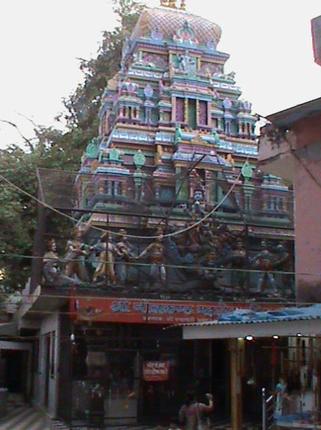South Meets North in Rishikesh

July 4, 2013: It is very rare to find a temple with typically south Indian gopuram in a north Indian pilgrim town like Rishikesh. What surprises one is that it is not in the plains, but in a hillock that can be reached after an hour’s drive by car.
It is the gopuram of Neelkant Mahadev temple that catches the eyes the moment one enters the area. The gopuram is built on the lines of the typical south Indian temple architecture with bright colours.
During a chat with Subhashji, the administrator, he revealed that he was fascinated by the design and architecture of the temples when he visited the South a few years ago on a pilgrimage. “I was attracted by the colour and grandeur of your mighty gopurams. Whether it is a small temple or big, they beckon the pilgrims from a distance. It is very distinct. It is very attractive. I therefore decided to have the gopuram for our temple in the southern style. That is what you see here!” he said.
“You do not find such temples in the north, except perhaps in Kasi!” added Subhashji. “The temple was very old but it was a small structure. The murti is a swayambu, which has grown big, in the past 40 years, and the number of devotees has also increased, despite the temple being located in a difficult terrain!”
On the Maha Sivaratri day the temple attracts large number of devotees. On normal days, devotees either walk the entire distance or drive up the hill in a two-wheeler or car. When asked about the name of the Sthapati who did this piece of south Indian work, Subhashji said, “He is Swaminatha Sthapati and he hails from Thirukkannapuram in Nagapattinam district.” When this writer called him on his mobile after landing in Chennai, he was pleasantly surprised that someone has noticed his contribution so far away in the north. He said his guru was Palanisami Sthapathi of Karaikudi.
“I did the work about 15 years ago, sir!” he said. “However, I have been regularly painting the gopuram with four or five artists once in five years, so that the colours are retained. I took a batch of six-seven of them with me only last month and completed the work. Initially we were 25 when we took up the construction of the gopuram. The swamiji there liked it very much and we only renovate it once in five years so that it looks fresh and does not lose its charm!” said Swaminatha Sthapathi.
Swaminatha Sthapathi who is now in Delhi, is engaged in building a Siva temple in Madhipur, near Punjabi Park. According to the Sthapati, although it is constructed by north Indian devotees, they preferred the south Indian architecture. In Pithampura too, he is constructing a temple for Krishna.
Expert in Jain temples
It’s surprising to note that he is an expert in building Jain temples! “Yes, I am now engaged in building the Jain temple in Huda City in the outskirts of Delhi, near Shalimar. It was designed by an engineer, Balubhai of Ahmedabad.”
What moves a pilgrim and kindles patriotic spirit in Neelkanth Mahadev temple is the portrait of a martyr Vivek Sajwan, who hailed from this holy place called Neelkanth, kept inside the temple complex. Vivek lost his life in the gun battle with Kashmiri terrorists on January 6, 1998. He was posthumously awarded the Sowrya Chakra. Those who come to worship Lord Neelkanth, reverentially stand before the portrait of the young martyr and pay their respects.
Another notable temple in Rishikesh is the Rishikesh Narayan temple or popularly known as Bharath’s temple, which is two kilometers from the bazaar area. There is a board which says the name of the temple is called Bharath temple rules out any connection with Bharatha, Lord Rama’s brother. Not many visitors or pilgrims to Rishikesh seem to visit this unique temple. This has, however, puranic significance.
“….This sacred place is called Hrishikesh and during Kaliyuga, my incarnation will be known by the name of Bharath. Whoever lives in and visits Bharath temple, after a holy bath in the sacred Mayakund, will be freed from all worldly bondages.”
The details further state that ‘in about 789 A.D., on the auspicious day of Basanth Panchami, Jagadguru Adi Sankaracharya re-installed the presiding deity in the temple. On this day every year, the salagramam is taken for a holy dip in the sacred Mayakund and then carried in a grand procession through the city and back to the temple for symbolic re-installation.’
It is also believed that, if any pilgrim, on the Akshaya Thritiya day, takes 108 parikramas of Lord Rishikesh Narayan at this temple and seeks the blessings at his feet (it is the only day Lord’s feet are left uncovered) will get all his wishes fulfilled and is considered equivalent to the pilgrimage to Badrinath. There is also a Samskrit Vidyalaya run by the temple authorities.
Source: The Hindu, DT. July 4, 2013.







